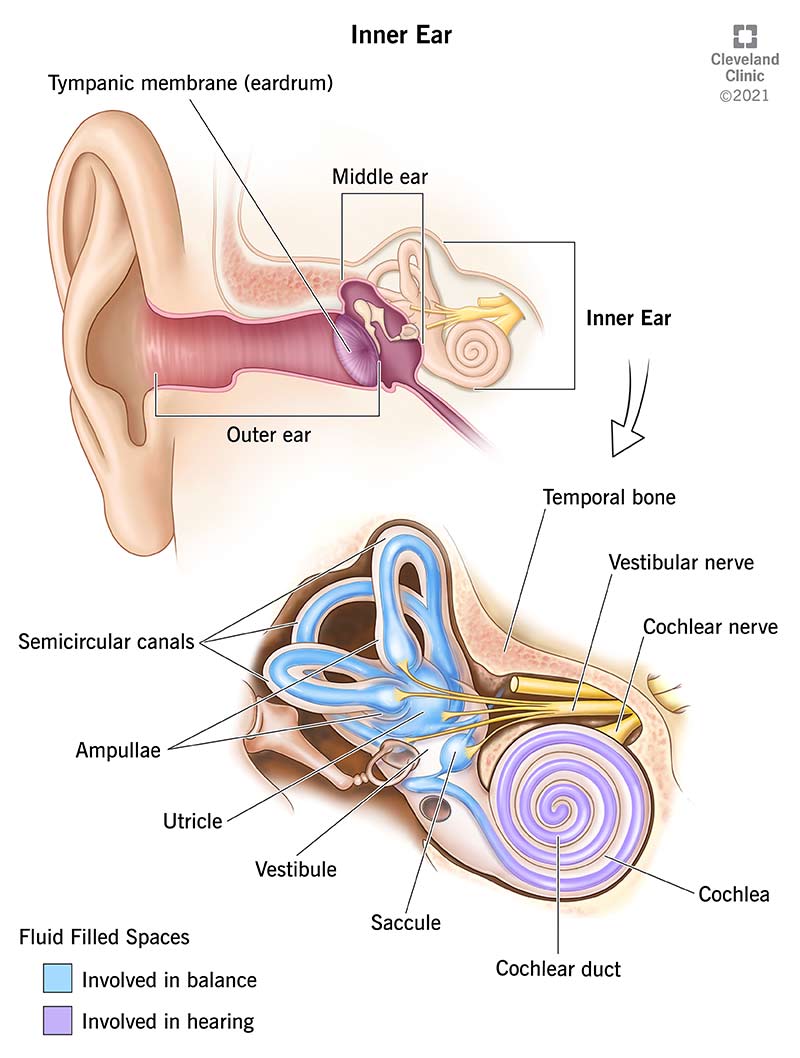Inner Ear
Your inner ear is the innermost part of your hearing system and home to your vestibular (balance) system. It contains the cochlea, which helps you hear, and the semicircular canals and otolith organs that help you balance. You can protect your inner ear by avoiding things, like loud noises, that can damage the sensitive structures inside.
Overview

What is the inner ear?
What we think of as the “ear” is actually a three-part structure. The outer ear is the part you see and your ear canal. The middle ear is a box-shaped area behind your tympanic membrane (eardrum) that includes the three smallest bones in your body. And the inner ear is just beyond the middle ear, in a small hole in the temporal bones that help make up the sides of your skull.
Although the structures within your inner ear are tiny and tucked away, they play a huge role in your outward experience of the world — both the sounds you hear and feelings of equilibrium within your body.
Function
What does the inner ear do?
Your inner ear has two jobs:
Your inner ear is the last stop that sound waves make in a carefully orchestrated journey that starts from your outer ear. These waves travel from your outer ear through your middle ear to your inner ear. Structures within your inner ear convert the sound waves into electrical energy. Your hearing (auditory) nerve delivers the energy to your brain as sound, making it possible for you to hear.
At the same time, your inner ear monitors your movements. It alerts your brain to changes in your position, so your brain can let your body know what to do to stay balanced.
Anatomy
What are the parts of the inner ear?
Your inner ear includes two parts: the cochlea (which supports your hearing) and the vestibular system organs (which support your balance).
Parts for hearing
Your cochlea is a snail-shaped organ within your inner ear that helps you hear. It’s filled with fluid that moves in response to sound waves and is split into three tubes by two thin membranes. One of these membranes — the basilar membrane — is like an elastic wall, on top of which sits the organ of Corti. The organ of Corti contains tiny hair cells with stereocilia at the ends. Stereocilia are delicate, hair-like projections that react to cochlea fluid movement.
Here’s how your cochlea turns sound waves into sounds:
- Sound enters your outer ear and hits your eardrum, causing the tiny middle ear bones (malleus, incus and stapes) to move.
- The stapes is in the oval window (a small hole) in your cochlea. When the stapes moves, it makes ripples in your cochlea’s fluid.
- This ripple moves the stereocilia at the ends of your hair cells like an ocean current moves plants on the seafloor.
- This movement of the stereocilia sparks an electrical signal that your hearing nerve carries to your brain. Your brain perceives the electrical signal as sound.
Parts for balance
The structures inside your inner ear that help you balance are part of your vestibular system. They include three fluid-filled semicircular canals and two otolith organs (the saccule and utricle).
Here’s what the parts are and what they do:
- Semicircular canals: Semicircular canals are tubes coiled within your inner ear. Like the cochlea, the canals are lined with hair cells. Instead of sound waves, these tiny hairs react to body movements. They’re mostly responsible for sensing rotary motion, or motion not in a straight line, like when you turn or tilt your head.
- Otolith organs within the vestibule: Your saccule and utricle contain tiny hairs and crystal-like structures called “otoconia.” They sense movement in your body when the fluid within your inner ear shifts. The utricle and saccule are mostly responsible for sensing when your body moves forward or backward, or up or down.
Movement of hair cells triggers an electrical impulse that travels from your vestibulocochlear nerve, or the 8th cranial nerve, to your brain. Your brain perceives the electrical signal as information about your balance.
Conditions and Disorders
What common conditions and disorders affect the inner ear?
Your hearing and your sense of balance rely on a healthy inner ear. The most common inner ear conditions and disorders that can get in the way of this include:
- Acoustic neuroma: A noncancerous tumor that can form on an important nerve involved in balance.
- Benign paroxysmal positional vertigo (BPPV): A vestibular (balance) disorder that happens when small fragments of your inner ear (otoconia) get trapped in your semicircular canal. This can make you feel like you’re moving when you aren’t.
- Hearing loss: A common condition with many causes and types, including age-related hearing loss (presbycusis), noise-induced hearing loss (NIHL) and sudden sensorineural hearing loss (SSNHL).
- Inner ear infection (otitis interna): Any condition that causes inflammation in your inner ear. The most common types are labyrinthitis and vestibular neuritis. Infections can cause severe hearing loss and prolonged dizziness.
- Ménière’s disease: Chronic (long-lasting) inner ear condition that causes fluctuating problems with both hearing and balance.
- Ototoxicity: Damage to your inner ear that’s a side effect of taking certain medications.
- Tinnitus: Ringing in your ears that’s often related to hearing loss
Other conditions that can cause inner ear problems include:
- Autoimmune inner ear disease.
- Earwax blockage.
- Hyperacusis.
- Otosclerosis.
- Perilymphatic fistula.
- Superior canal dehiscence syndrome.
- Susac syndrome.
Common signs or symptoms of an inner ear problem
Signs of an inner ear problem include:
- Trouble understanding what people are saying.
- Unpleasant sensations in your ear, like pain, ringing or pressure.
- Headaches.
- Dizziness.
- Vertigo (feeling as if you or your surroundings are spinning).
- Perceiving objects as moving when they’re not (oscillopsia).
You may experience other symptoms depending on the specific inner ear condition.
How do healthcare providers diagnose inner ear problems?
Healthcare providers use several tests to check the inner ear and diagnose inner ear problems, including:
- Hearing tests: Tests that check how the hearing system within your inner ear is working include the otoacoustic emissions (OAE) test and the auditory brainstem response (ABR) test. The OAE test checks how the sensory hair cells within your inner ear are working. The ABR test checks how well your main hearing nerve is working.
- Vestibular tests: A vestibular test battery includes several tests that check how well the vestibular (balance) part of your inner ear is working.
What are common treatments for inner ear problems?
Depending on your diagnosis, treatments may involve managing or curing your condition. Common treatments include:
- Medications: Treatments include antibiotics or antivirals to treat infections, water pills (diuretics) to help regulate inner ear fluid, steroids to reduce inflammation and medications to manage symptoms.
- Hearing-assistive devices: Treatments include hearing aids and cochlear implants.
- Rehabilitation: Treatments include vestibular rehabilitation therapy that improves how all the parts of your vestibular system work together to maintain balance.
- Surgery: Treatments include procedures that repair damaged parts of your inner ear or remove growths.
Care
How can I protect my inner ear?
There are several ways to protect your inner ear from hearing loss. Here are some important ones:
- Turn the volume down. This includes when you’re watching television or videos or listening to music — particularly when wearing earbuds.
- Avoid sources of loud noises. This may mean staying far away from the speakers at a concert or show.
- Use hearing protection devices. Wear earplugs, earmuffs or noise-canceling headphones when you can’t avoid loud sounds.
- Seek early treatment for inner ear problems. The sooner you get treated, the greater the chance you’ll prevent serious long-term damage.
A note from Cleveland Clinic
Your inner ear is a complicated, delicate and essential part of your body. Every minute of every day, your inner ear turns sound waves into sounds that keep you safe and enrich your life. It also helps you stay balanced. Hearing loss and balance problems can come without warning and interfere with how you’re able to use the sensory information associated with your inner ear. Without treatment, inner ear problems and can worsen over time. Talk to your healthcare provider as soon as you suspect something might be wrong with your inner ear.


